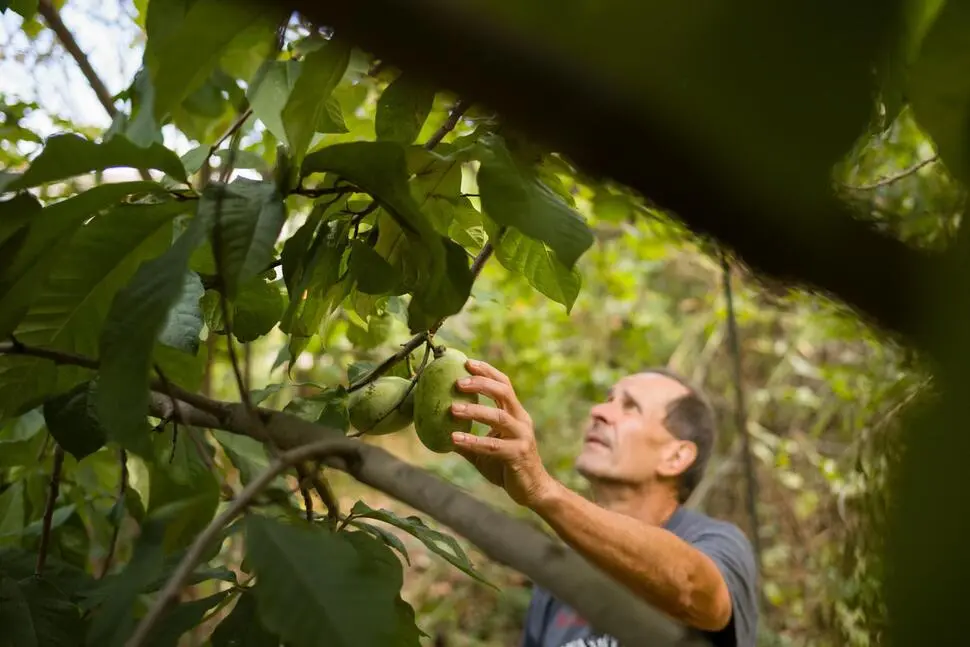What began as a modest attempt to bring the American pawpaw tree back to the Pittsburgh area has blossomed into a regional restoration movement.
On a wooded slope above the Allegheny River, Gabrielle Marsden brushed her hand against an elongated green leaf — Asimina triloba, better known as the American pawpaw.
The deciduous tree produces North America’s largest native fruit and serves as a vital host for the zebra swallowtail butterfly — a species now nearly vanished from western Pennsylvania.
“They’re basically gone from here,” Marsden said while trekking along the riverbank. “The closest ones I’ve seen are in northern West Virginia.”
“The key to bringing back any species is restoring its natural habitat,” she added, pausing beneath a cluster of pawpaw trees rising 40 feet above the railway, beside the rusted shell of an old Ford sedan. “Once you do that, nature takes care of the rest.”
Marsden has become one of the region’s most visible advocates for reintroducing both the pawpaw and the butterfly that relies on it. She’s part of a growing network of enthusiasts and conservation groups planting pawpaws and working to revive the zebra swallowtail population.
Like many butterflies, the zebra swallowtail depends on a single plant species — in this case, the pawpaw. Its caterpillars feed exclusively on the tree’s long, oval leaves.
Kevin Keegan, insect collection manager at the Carnegie Museum of Natural History, explained that zebra swallowtails once fluttered throughout Pittsburgh’s river valleys. But the rise of steel mills, rail lines, and heavy industry erased much of their habitat. He estimates industrialization wiped out up to 95% of the local population, leaving perhaps only a hundred butterflies in the entire region.
Marsden has even imported and released a few herself, while others have reported rare sightings of solitary swallowtails drawn to backyard pawpaw trees.
“We can — and should — bring them back,” Marsden said. Then she smiled. “Besides, pawpaws taste amazing.”
On the opposite bank of the river, Joe Kostka stood in his backyard orchard surrounded by pawpaw trees heavy with fruit. Green, fist-sized clusters carpeted the ground as he inspected them for ripeness.
“Look at this one,” he said, pointing to a mango-sized fruit hanging overhead. “If that dropped on your head, you’d feel it.”
Kostka and his wife, Diane, have cultivated pawpaws at their Natrona Heights orchard for over two decades. They’ve even competed — and placed — at Ohio’s annual pawpaw festival. Their basement refrigerator holds dozens of pawpaw varieties, from Shenandoah to Susquehanna, many developed through the research program at Kentucky State University.
After the pandemic, Marsden began hosting an annual “pawpaw party” to raise awareness about the fruit and its ecological role. Each year attendance has doubled, drawing nearly 200 people this time around.
“I’d been looking for pawpaws for four years,” said Adell Kitchens, a forager and native plant enthusiast from McKees Rocks. “I could never find one.”
The fruit can be elusive — its season lasts only a few weeks in late summer, and it’s rarely sold in markets. “It’s local, though,” Kitchens said. “We should all have access to it.” She described the flavor as a mix between pear, banana, and avocado.
Visitors sampled wild and cultivated pawpaws, along with pawpaw ice cream, cheesecake, kombucha, and beer.
Under a canopy, grower Jasen Bernthisel sold the last of his pawpaw saplings — several hundred had already gone that year. “Pawpaws are taking off,” he said. Compact, hardy, and quick to bear fruit, the trees make ideal additions to home gardens.
“People are catching on,” he added, glancing at the crowd. “This turnout proves it.”
Meanwhile, on the former site of a steel mill in Upper Lawrenceville, Tree Pittsburgh has been nurturing thousands of pawpaw trees. For 15 years, the nonprofit has focused on growing native species and has carefully built a diverse gene pool by collecting seeds across northern Appalachia. Their pawpaws now grow in city parks, riverfront restoration sites, and community orchards — and hundreds have been adopted by local residents.
“Demand is way higher than what we can produce,” said Megan Palomo, who manages the organization’s nursery, which grows about 300 pawpaws each year.
After two decades of cultivation, the Kostkas finally spotted a zebra swallowtail gliding above their orchard last summer. A few days later, they found eggs nestled on a pawpaw leaf.
Now proud members of the North American Pawpaw Growers Association, the couple carries seeds on every hike, planting them in shallow holes along the Allegheny River. They hope others will join in the effort — and maybe, just maybe, help bring the zebra swallowtail home again.
Keegan remains optimistic. “Every little effort counts,” he said.
